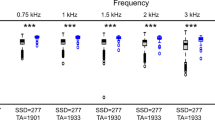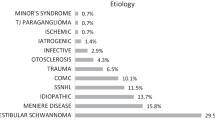Abstract
Background
Patients with single-sided deafness (SSD) are limited by their asymmetric hearing in various areas of everyday life.
Objective
The aim of this investigation was to perform an age-correlated comparison of the hearing threshold of the better ear of SSD patients with a normal-hearing (NH) reference cohort. In addition, the potential influence of etiology, duration of deafness, and cochlear implantation (CI) of the poorer ear on the peripheral hearing ability of the better ear was investigated.
Materials and methods
In a multicenter study, the mean bone conduction hearing threshold of the better ear of 413 adult SSD patients was compared with that of an NH cohort drawn from ISO 7029:2017 for the frequencies 0.5, 1, 2, and 4 kHz.
Results
SSD patients showed significantly poorer hearing in the better ear compared to the age-correlated group of NH subjects. CI, duration of deafness, and etiology had no significant effect on the hearing ability of the better ear.
Conclusion
The origin of the poorer hearing of the better-hearing ear of SSD patients compared to an age-correlated NH cohort is still unclear. It is most likely a combination of different anatomical, immunological, etiological, and microcirculatory causes, which lead to poorer hearing of the better-hearing ear in SSD patients.






Similar content being viewed by others
References
Arndt S, Aschendorff A, Laszig R, Beck R, Schild C, Kroeger S, Ihorst G, Wesarg T (2011) Comparison of pseudobinaural hearing to real binaural hearing rehabilitation after cochlear implantation in patients with unilateral deafness and tinnitus. Otol Neurotol 32:39–47
Arndt S, Laszig R, Aschendorff A, Hassepaß F, Wesarg T (2017) Cochlear implant treatment of patients with single-sided deafness or asymmetric hearing loss. HNO 65:98–108
Feuerstein JF (1992) Monaural versus binaural hearing: Ease of listening, word recognition, and attentional effort. Ear Hear 13:80–86
Hol M, Kunst S, Snik A, Bosman A, Mylanus E, Cremers C (2010) Bone-anchored hearing aids in patients with acquired and congenital unilateral inner ear deafness (Baha CROS): Clinical evaluation of 56 cases. Ann Otol Rhinol Laryngol 119:447–454
Wie OB, Pripp AH, Tvete O (2010) Unilateral deafness in adults: Effects on communication and social interaction. Ann Otol Rhinol Laryngol 119:772–781
Buechner A, Brendel M, Lesinski-Schiedat A, Wenzel G, Frohne-Buechner C, Jaeger B, Lenarz T (2010) Cochlear implantation in unilateral deaf subjects associated with ipsilateral tinnitus. Otol Neurotol 31:1381–1385
Finke M, Bönitz H, Lyxell B, Illg A (2017) Cochlear implant effectiveness in postlingual single-sided deaf individuals: What’s the point? Int J Audiol 56(6):417–423
Kitzes LM (1984) Some physiological consequences of neonatal cochlear destruction in the inferior colliculus of the gerbil, Meriones unguiculatus. Brain Res 306:171–178
Reale RA, Brugge JF, Chan JC (1987) Maps of auditory cortex in cats reared after unilateral cochlear ablation in the neonatal period. Brain Res 431:281–290
Scheffler K, Bilecen D, Schmid N, Tschopp K, Seelig J (1998) Auditory cortical responses in hearing subjects and unilateral deaf patients as detected by functional magnetic resonance imaging. Cereb Cortex 8:156–163
Bilecen D, Seifritz E, Radü EW, Schmid N, Wetzel S, Probst R, Scheffler K (2000) Cortical reorganization after acute unilateral hearing loss traced by fMRI. Neurology 54:765–767
Ponton CW, Vasama JP, Tremblay K, Khosla D, Kwong B, Don M (2001) Plasticity in the adult human central auditory system: Evidence from late-onset profound unilateral deafness. Hear Res 154:32–44
Langers DRM, Van Dijk P, Backes WH (2005) Lateralization, connectivity and plasticity in the human central auditory system. Neuroimage 28:490–499
Lim HW, Lee JW, Chung JW (2014) Vulnerability to acoustic trauma in the normal hearing ear with contralateral hearing loss. Ann Otol Rhinol Laryngol 123(4):286–292
Rajan R (2001) Unilateral hearing losses alter loud sound-induced temporary threshold shifts and efferent effects in the normal-hearing ear. J Neurophysiol 85:1257–1269
Güttich A (1927) Zur pathologischen Anatomie der sympathischen Labyrinthitis. Passow-Schaefer-Beitr Anat Physiol Pathol Ther Ohres 27:6–9
Dutta Majumder P, Anthony E, George AE, Ganesh SK, Biswas J (2017) Postsurgical sympathetic ophthalmia: Retrospective analysis of a rare entity. Int Ophthalmol 38(6):2487–2493
Van de Heyning P, Távora-Vieira D, Mertens G et al (2016) Towards a unified testing framework for single-sided deafness studies: A consensus paper. Audiol Neurootol 21(6):391–398
ISO 7029:2017: International Organization of Standardization: Acoustics—Threshold of Hearing by Air Conduction as a Function of Age and Sex for Otologically Normal Persons. Geneva, International Organization of Standardization
R Core Team (2014) R: A language and environment for statistical computing. R Foundation for Statistical Computing, Vienna, Austria
Alhanbali S, Dawes P, Lloyd S, Munro KJ (2017) Self-reported listening-related effort and fatigue in hearing-impaired adults. Ear Hear 38(1):e39–e48
Nelson EG, Hinojosa R (2006) Presbycusis: A human temporal bone study of individuals with downward sloping audiometric patterns of hearing loss and review of the literature. Laryngoscope 116(9):1–12
Schuknecht HF, Gacek MR (1993) Cochlear pathology in presbycusis. Ann Otol Rhinol Laryngol 102(1):1–16
ten Cate WJ, Bachor E (2005) Autoimmune-mediated sympathetic hearing loss: A case report. Otol Neurotol 26:161–165
Bachor E, ten Cate WJ, Gloddek B, Ehsani N (2000) Immunhistochemischer Nachweis von humoralen Auto-Antikörpern bei Patienten mit einer Hörminderung auf dem letzthörenden Ohr. Laryngorhinootologie 79:131–134
Feldmann H (1987) Spätfolgen nach laterobasalen Frakturen, therapeutische und gutachtliche Gesichtspunkte. Laryngol Rhinol Otol (Stuttg) 66:91–98
McCabe BF (1979) Autoimmune sensorineural hearing loss. Ann Otol Rhinol Laryngol 88:585–589
Hueb MM, Goycoolea MV, Paparella MM, Oliveira JA (1991) Otosclerosis: The University of Minnesota temporal bone collection. Otolaryngol Head Neck Surg 105:396–405
Perez R, Chen JM, Nedzelski JM (2004) The status of the contralateral ear in established unilateral Menière’s disease. Laryngoscope 114:1373–1376
Archibald HD, Ascha M, Gupta A, Megerian C, Otteson T (2019) Hearing loss in unilateral and bilateral enlarged vestibular aqueduct syndrome. Int J Pediatr Otorhinolaryngol 118:147–151
Marcus S, Whitlow CT, Koonce J, Zapadka ME, Chen MY, Williams DW 3rd, Lewis M, Evans AK (2014) Computed tomography demonstrates abnormalities of contralateral ear in subjects with unilateral sensorineural hearing loss. Int J Pediatr Otorhinolaryngol 78(2):268–271
Ukaegbe O, Ezeanolue B, Orji F (2016) The influence of tinnitus on the audiometric threshold of sufferers. Int Arch Otorhinolaryngol 20:339–343
Mertens G, Kleine Punte A, De Ridder D, Van de Heyning P (2013) Tinnitus in a single-sided deaf ear reduces speech reception in the nontinnitus ear. Otol Neurotol 34(4):662–666
Acknowledgements
We thank the Förderverein Taube Kinder lernen Hören e. V. Freiburg for the financial support of our research work. Special thanks also are due to Dr. E. Kludt, who compiled the retrospective data at the ENT Clinic of the Medizinischen Hochschule Hannover and to Dr. S. Schmidt at the Bundeswehrkrankenhaus Koblenz for her support in the revision of the manuscript.
Author information
Authors and Affiliations
Corresponding author
Ethics declarations
Conflict of interest
S. Arndt reports the following: Advanced Bionics: travel cost reimbursement, financial support for research; Cochlear: financial support for research, travel cost reimbursement; MED-EL: financial support for research, travel cost reimbursement; Oticon Medical: travel cost reimbursement. T. Wesarg reports the following: Advanced Bionics: financial support for research, travel cost reimbursement; Cochlear: financial support for research, travel cost reimbursement; MED-EL: financial support for research, travel cost reimbursement; Phonak Communications: financial support for research, travel cost reimbursement; Oticon Medical: travel cost reimbursement. A. Aschendorff reports the following: Advanced Bionics: financial support for research, Medical Advisory Board, travel cost reimbursement; Cochlear: financial support for research, travel cost reimbursement; MED-EL: financial support for research, travel cost reimbursement; Oticon Medical: financial support for research, travel cost reimbursement. Y. Stelzig, R. Jacob, A. Illg, A. Lesinski-Schiedat, M.C. Ketterer and I. Speck declare that they have no competing interests.
The present study was performed with approval of the Ethics Commission Freiburg (No. 381/18) for the Universitätsklinikum Freiburg and Bundeswehrkrankenhaus Koblenz and the Ethics Commission Hannover (No. 1897-2013) for the Medizinische Hochschule Hannover in compliance with national law and the Declaration of Helsinki of 2013 (in the current, revised edition) (DRKS00015740).
The supplement containing this article is not sponsored by industry.
Rights and permissions
About this article
Cite this article
Arndt, S., Wesarg, T., Stelzig, Y. et al. Influence of single-sided deafness on the auditory capacity of the better ear. HNO 68 (Suppl 1), 17–24 (2020). https://doi.org/10.1007/s00106-019-00739-6
Published:
Issue Date:
DOI: https://doi.org/10.1007/s00106-019-00739-6




